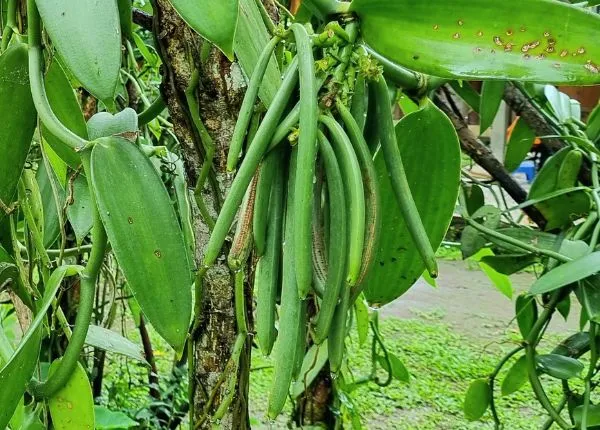Panili – Vanilla
Panili – Vanilla
Table of Contents
What is Vanilla?
Vanilla (Vanilla planifolia) is a tropical vine that can grow up to 300 feet in its natural habitat, climbing on trees for support. When cultivated, it’s typically kept shorter for easier harvesting.

What is it?
- Botanical Name: Vanilla planifolia
- Family: Orchidaceae (Orchid family)
- Type: A vining, climbing orchid native to Mexico.
- The “Bean”: The vanilla “bean” is actually the cured fruit pod of the vanilla orchid.
More Details About Vanilla:
- Growth Habit: Vanilla is a tropical vine that can grow up to 300 feet in its natural habitat, climbing on trees for support. When cultivated, it’s typically kept shorter for easier harvesting.
- Leaves: Thick, fleshy, and oblong.
- Flowers: Beautiful, pale yellow-green, and fragrant, but each flower only opens for one day.
- Pollination: In the wild, vanilla was traditionally pollinated by a specific bee in Mexico. Today, almost all commercial vanilla is hand-pollinated, a labor-intensive process that contributes to its high cost.
- Fruit: Long, slender pods that take about six to nine months to mature after pollination.
Where is it Grown?
While native to Mexico, vanilla is now grown in many tropical regions around the world, including:
- Madagascar (the world’s largest producer)
- Indonesia
- Uganda
- Mexico
- Tahiti
Fun Facts:
- Vanilla is the only edible fruit of the orchid family, one of the largest plant families in the world.
- The Aztecs used vanilla to flavor their chocolate drinks.
- Vanilla is the second most expensive spice in the world (after saffron) due to the labor-intensive cultivation and curing processes.
What is the vanilla plant used for?
The vanilla plant is primarily known for its fruit, commonly called the “vanilla bean.”
- Food: Vanilla is widely used in desserts, baked goods, beverages, and ice cream.
- Fragrance: It’s a popular ingredient in perfumes and aromatherapy.
- Medicinal: Traditionally, vanilla has been used for its potential antioxidant and calming properties.

Why are vanilla plants so expensive?
There are several good reasons why:
1. Labor-Intensive Cultivation:
- Hand Pollination: Vanilla orchids are native to Mexico, where they were originally pollinated by a specific species of bee. Outside of Mexico, these bees are not present, so each vanilla flower must be hand-pollinated. This is a delicate and time-consuming process, as the flowers only open for a single day each year.
- Long Maturation: It takes about three years for a vanilla vine to mature enough to produce flowers. After pollination, it takes another six to nine months for the beans to fully develop.
- Curing Process: Once harvested, the vanilla beans undergo a lengthy curing process that can take several months. This involves repeated sun-drying, sweating, and careful monitoring to develop the characteristic vanilla flavor and aroma.
2. Limited Growing Regions:
- Vanilla orchids require specific tropical climates with high humidity and warm temperatures. This limits the regions where they can be successfully cultivated, with major production areas including Madagascar, Indonesia, and Mexico.
3. High Demand:
- Vanilla is a widely used flavoring in food, beverages, cosmetics, and fragrances. The demand for natural vanilla extract remains high, despite the availability of synthetic alternatives.
4. Vulnerability to Weather and Disease:
- Vanilla crops are susceptible to damage from extreme weather events like cyclones and droughts. Diseases can also devastate vanilla plantations, further impacting supply.
5. Theft:
- Due to its high value, vanilla beans are sometimes targeted by thieves, adding to the challenges faced by farmers.
The high price of vanilla is a result of the combination of labor-intensive cultivation methods, limited growing regions, high demand, and vulnerability to various risks. This makes vanilla a precious and sought-after spice.
Can you eat vanilla leaf?
No, you cannot eat vanilla leaves. While they are not poisonous, they are not considered palatable and may cause stomach upset.
